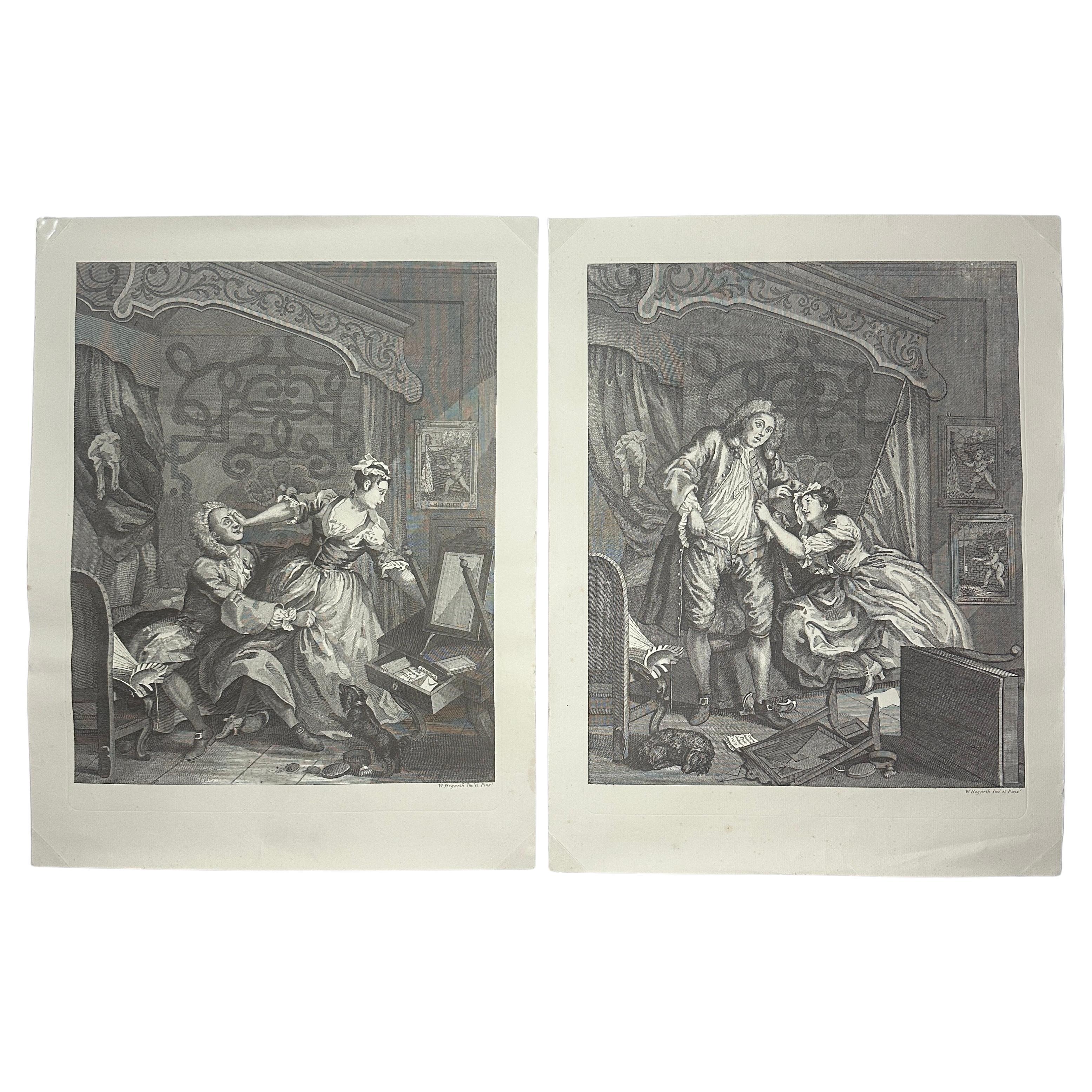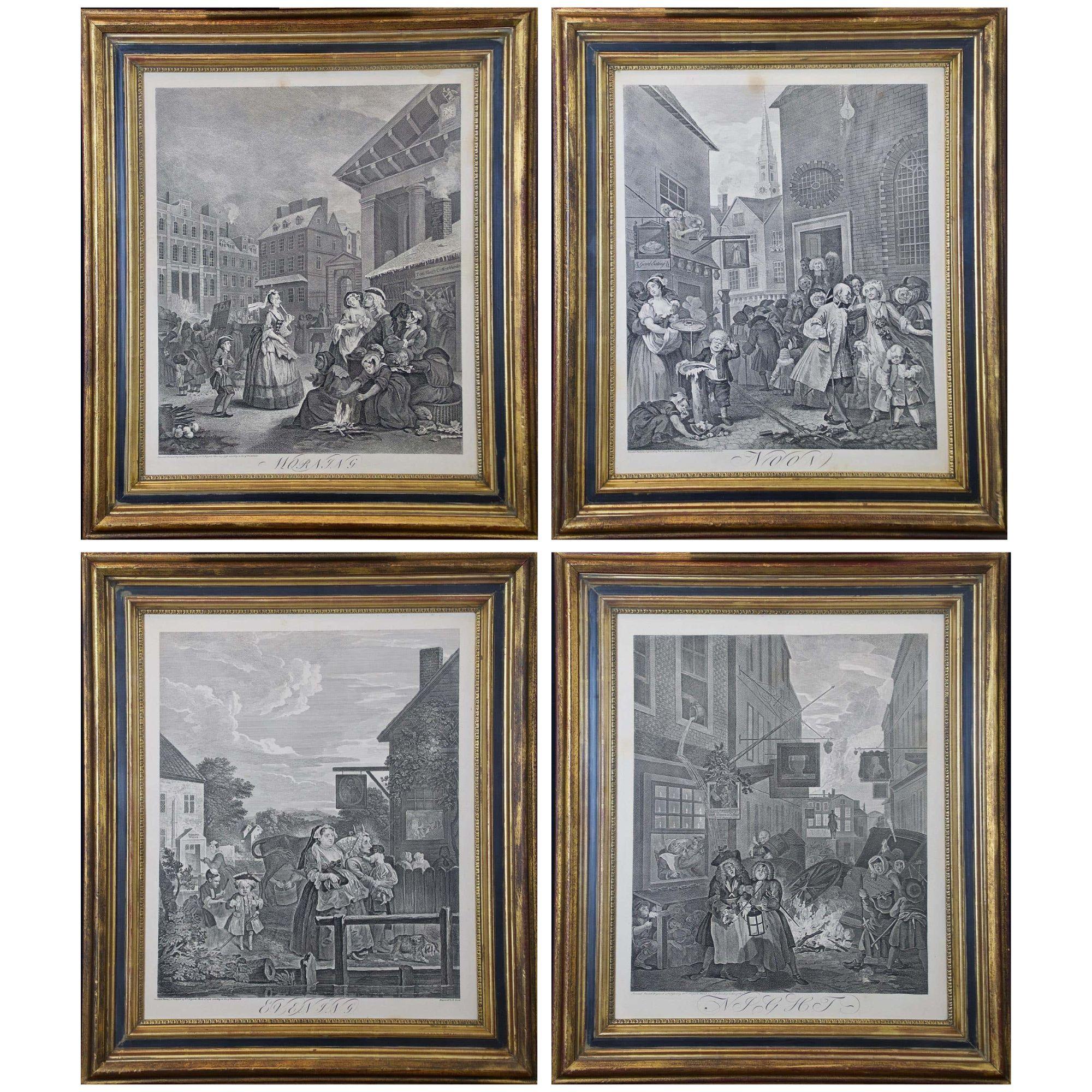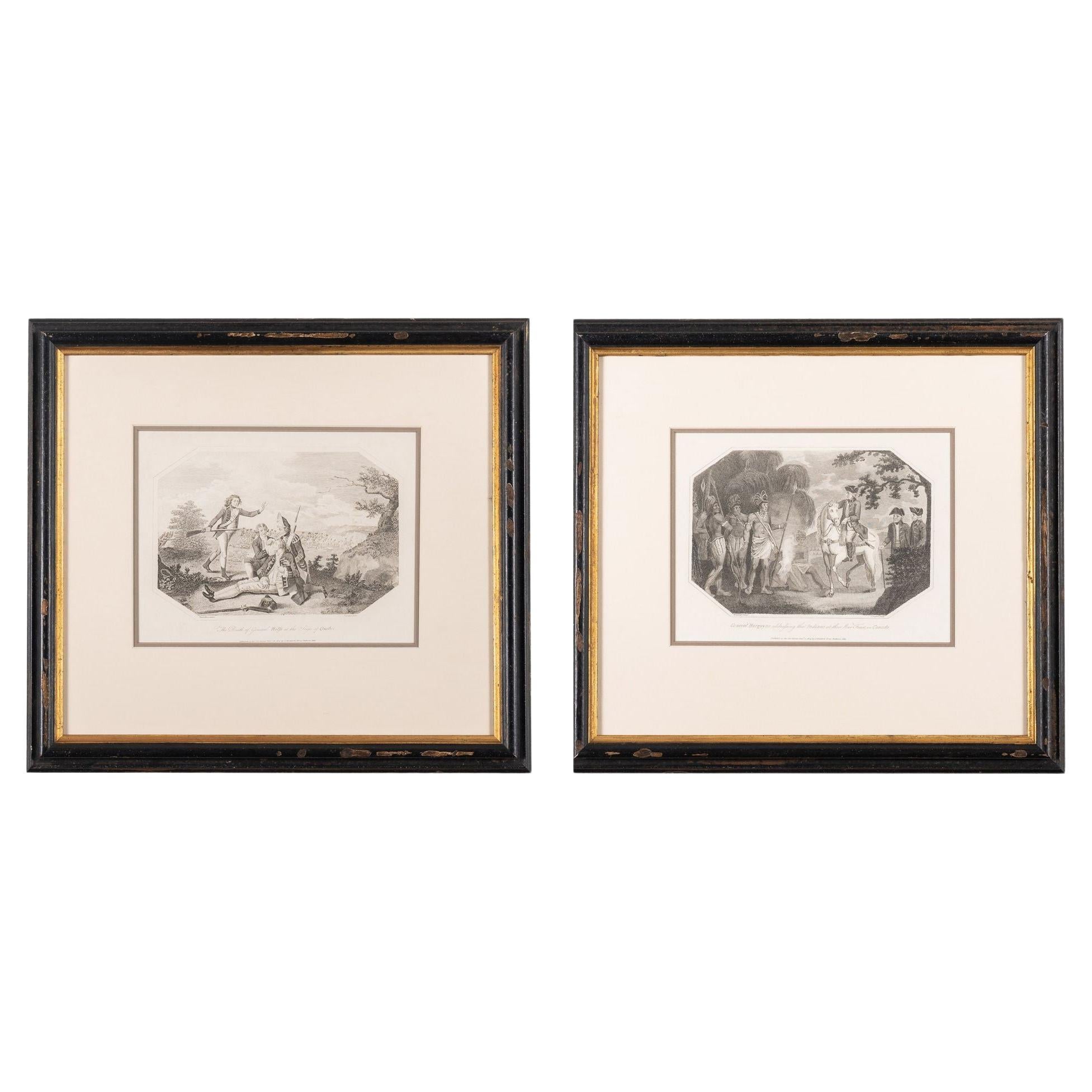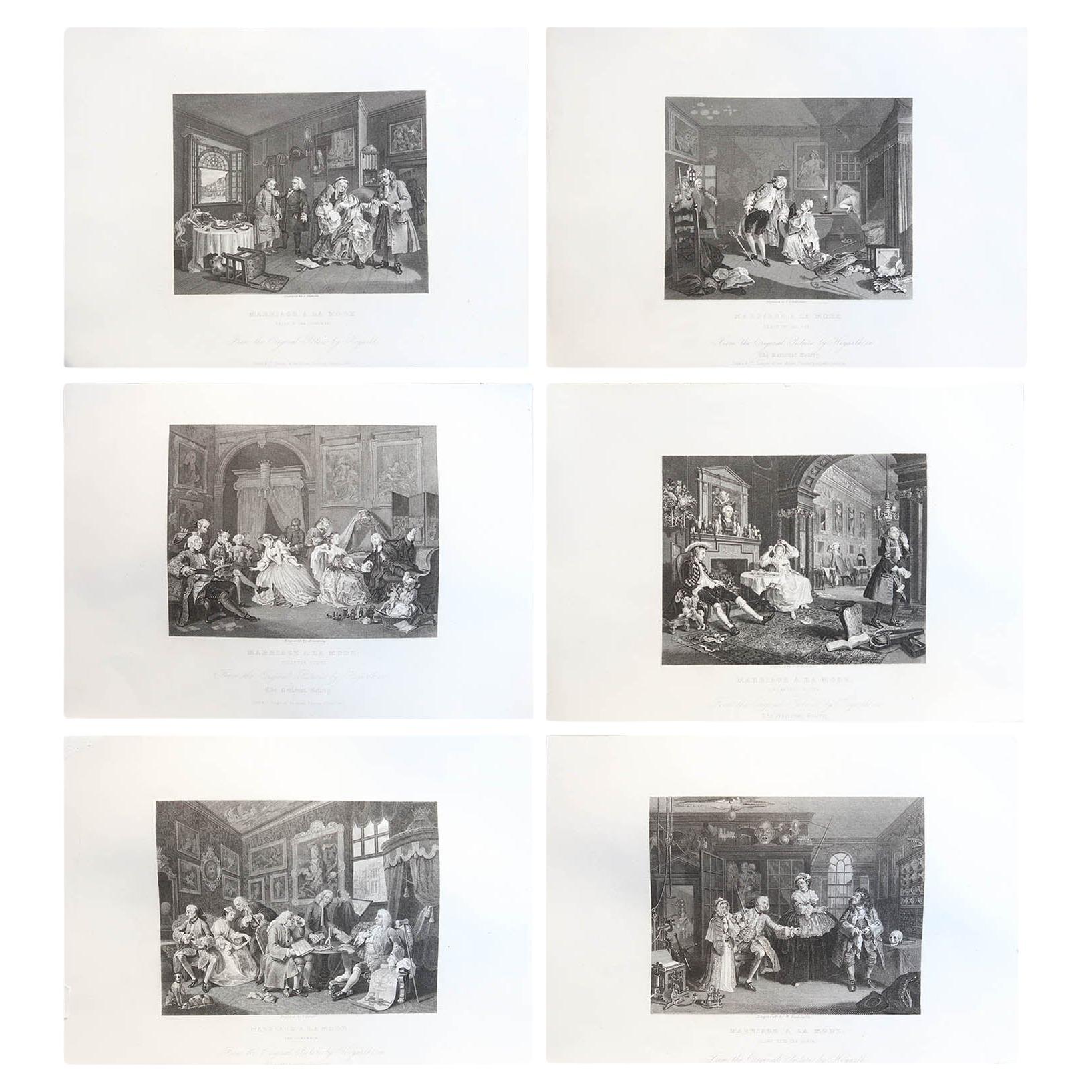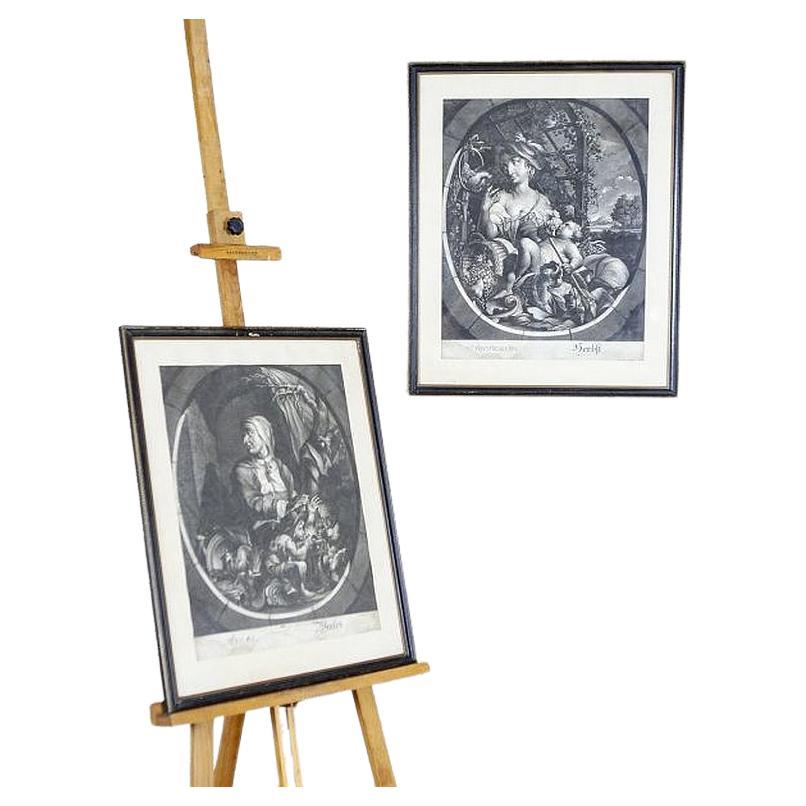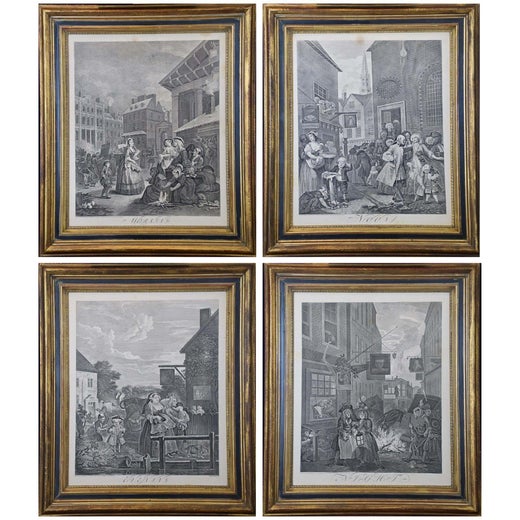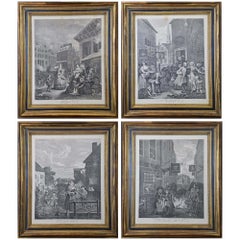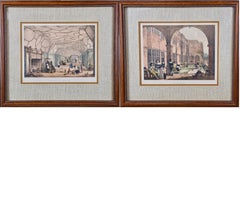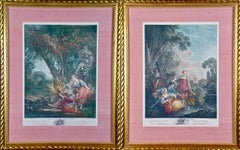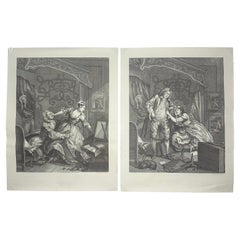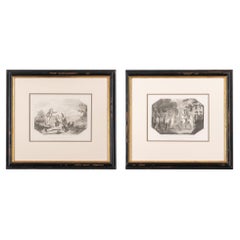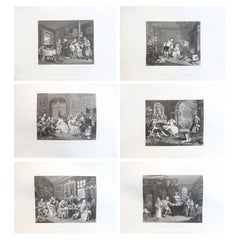Items Similar to William Hogarth's "Analysis of Beauty": A Set of Two Framed 18th C. Engravings
Want more images or videos?
Request additional images or videos from the seller
1 of 16
William HogarthWilliam Hogarth's "Analysis of Beauty": A Set of Two Framed 18th C. Engravings1753
1753
$2,380
$2,97520% Off
£1,852.99
£2,316.2420% Off
€2,107.38
€2,634.2320% Off
CA$3,423.56
CA$4,279.4520% Off
A$3,761.39
A$4,701.7420% Off
CHF 1,965.72
CHF 2,457.1620% Off
MX$44,857.68
MX$56,072.1020% Off
NOK 24,891.40
NOK 31,114.2520% Off
SEK 23,188.44
SEK 28,985.5420% Off
DKK 15,747.36
DKK 19,684.1920% Off
About the Item
The two plates in this set were created utilizing both engraving and etching techniques by William Hogarth in 1753, originally as illustrations of his book on aesthetics, entitled "Analysis of Beauty". Due to their popularity, these plates were later published separately. The publication line in the lower right reads: "Designed, Engraved, and Publish'd by Wm. Hogarth, March 5th 1753, according to Act of Parliament." Hogarth's original copper plates were refurbished where needed by James Heath and engravings were republished in London in 1822 by Braddock, Cradock & Joy. This was the last time Hogarth's copper plates were used for printing. Most were melted during World War I for the construction of bombs.
These large folio sized "Analysis of Beauty" engravings are presented in antiqued gold-colored frames with double mats; the outer silk mats are light brown-colored and the inner mats are dark brown. Each frame measures 27.38" x 31.25" x 1.13". There is one tiny spot in the right margin of plate 1 and another in the lower margin; the latter could be from the printing process. The prints are otherwise in excellent condition.
The "Analysis of Beauty" series is in the collection of many major museums, including: The British Museum, The Metropolitan Museum of Art, The Tate Museum, The Chicago Art Institute and The Fine Arts Museums of San Francisco.
The first engraving (Plate 1) depicts a courtyard of statues which is filled with some of the most famous works of classical sculpture. The most important sculptures are surrounded by less impressive works. The Medicean Venus (#13) is in the center with a statue of Julius Caesar (#19) to the right, elevated on a pulley with a short, overdressed Brutus stands over the falling Caesar. The Apollo Belvedere (#12) is next. A judge stands to the right with his foot on a cherub (#16). Another crying cherub holds a gallows and wipes his tears with the judge's robe.
A sphinx (#21) and the drunken Silenus (#107) are below the Venus. Michaelangelo's torso (#54) and a statue of Antonius (#6) are seen in the foreground. The Farnese Hercules (#3) and a bust of another Hercules (#4) under two statuettes of Isis are also included in the scene.
The key to these objects is included in the form of a serpentine line winding around a cone (#26), Hogarth's "Line of Beauty". For Hogarth the winding line is an essential element of beauty in art. Hogarth's theory of beauty is communicated in this plate.
Plate 2 is thought to represent the Wanstead Assembly, with the Earl of Tynley and his household. It is an adaptation of a scene in the Happy Marriage series, which complements Hogarth's Marriage à la Mode series. Hogarth scholars feel this represents Hogarth's theory about the linear presentation of attitude and action. as described in this excerpt from the text of Hogarth's "Analysis of Beauty": "Thus, as two or three lines at first are sufficient to shew the intention of an attitude, I will take this opportunity of presenting my reader (who may have been at the trouble of following me thus far) with a sketch of a country-dance, in the manner I began to set out the design; in order to shew how few lines are necessary to express the first thoughts, as to different attitudes; see fig. 71. T. p. 2, which describe in some measure, the several figures and actions, mostly of the ridiculous kind, that are represented in the chief part of plate 2. The most amiable person may deform his general appearance by throwing his body and limbs into plain lines, but such lines appear still in a more disagreeable light in people of a particular make, Ihave therefore chose such figures as I thought would agree best with my first score of lines, fig. 71.
The two parts of curves next to 71 served for the figures of the old woman with her partner at the farther end of the room. The curve and two straight lines at right angles, gave the hint for the fat man's sprawling posture. I next resolved to keep a figure within the bounds of a circle, which produced the upper part of the fat woman, between the fat man and the aukward one in the bag wig, for whom I had mad a sort of an X. The prim lady, his partner, in the riding-habit, by pecking back her elbows, as they call it, from the waste upwards, made a tolerable D, with a straight line under it, to signify the scanty stiffness of her peticoat; and a Z stood for the angular position the body makes with the legs and thighs of the affected fellow in the tye-wig; the upper parts of his plump partner was confin'd to an O, and this chang'd into a P, served as a hint for the straight lines behind. The uniform diamond of a card, was filled up the the flying dress, &c. of the little capering figure in the spencer-wig; whilst a double L mark'd the parallel position of his poking partner's hand and arms: and lastly, the two waving lines were drawn for the more genteel turns of the two figures at the hither end.
The best representation in a picture, of even the most elegant dancing, as every figure is rather a suspended action in it than an attitude, must be always somewhat unnatural and ridiculous; for were it possible in a real dance to fix every person at one instant of time, as in a picture, not one in twenty would appear to be graceful, tho' each were ever so much in their movements; nor could the figure of the dance itself be at all understood.
The dancing-room is also ornamental purposely with such statues and pictures as may serve to a farther illustration. Henry viii. fig. 72. p. 2, makes a perfect X with his legs and arms; and the position of Charles the first, fig. 51. p. 2, is composed of less-varied lines than the statue of Edward the sixth, fig. 73. p. 2; and the medal over Q. Elizabeth, as well as her figure, is in contrary; so are also the two other wooden figures at the end. Likewise the comical posture of astonishment (expressed by following the direction of one plain curve, as the dotted line in french print of Sancho, where Don Quixote demolishes the puppet shew, fig. 75, R. p. 2) is a good contrast to the effect of the serpentine lines in the fine turn of the Samaritan woman, fig. 74. L. p. 2, taken from one of the best pictures Annibal Carrache ever painted."
In the right-hand corner of the print a young wife or daughter is being told to leave the dance by a country squire who points insistently to his watch. The girl accepts a letter from her lover as she puts on her cloak.
Artist: William Hogarth (1697-1764) was an English painter, printmaker, pictorial satirist, social critic, and editorial cartoonist. Hogarth's work was extremely diverse, ranging from serious realistic paintings and portraits to satire and moralistic pieces filled with symbolism. He often communicated his moral message in a series of paintings and engravings, such as: A Rake's Progress, Marriage A-la-Mode and A Harlot's Progress. He was by far the most significant English artist of his generation and inspired a movement of English caricaturists and satirists, including James Gillray (1756-1815), Thomas Rowlandson (1757-1827), Isaac Cruickshank (1764-1811) and George Cruickshank (1792-1878). His work has been studied intensely for the greater than two and a half centuries since his death with several academic scholars focusing their careers on the analysis of every element of each of his creations.
- Creator:William Hogarth (1697 - 1764, British)
- Creation Year:1753
- Dimensions:Height: 27.38 in (69.55 cm)Width: 31.25 in (79.38 cm)Depth: 1.13 in (2.88 cm)
- Medium:
- Movement & Style:
- Period:
- Condition:
- Gallery Location:Alamo, CA
- Reference Number:Seller: #'s 1168 & 11691stDibs: LU117326014012
William Hogarth
William Hogarth (1697-1764) was an English painter, printmaker, pictorial satirist, social critic, and editorial cartoonist. Hogarth's work was extremely diverse, ranging from serious realistic paintings and portraits to satire and moralistic pieces filled with symbolism. He often communicated his moral message in a series of paintings and engravings, such as: A Rake's Progress, Marriage A-la-Mode and A Harlot's Progress. He was by far the most significant English artist of his generation and inspired a movement of English caricaturists and satirists, including James Gillray (1756-1815), Thomas Rowlandson (1757-1827), Isaac Cruickshank (1764-1811) and George Cruickshank (1792-1878). His work has been studied intensely for the greater than two and a half centuries since his death with several academic scholars focusing their careers on the analysis of every element of each of his creations.
About the Seller
5.0
Platinum Seller
Premium sellers with a 4.7+ rating and 24-hour response times
Established in 2011
1stDibs seller since 2019
296 sales on 1stDibs
Typical response time: 1 hour
- ShippingRetrieving quote...Shipping from: Alamo, CA
- Return Policy
More From This Seller
View AllFour Framed Hogarth Engravings "Four Times of the Day"
By William Hogarth
Located in Alamo, CA
The four plates in this "Four Times of the Day" set were created utilizing both engraving and etching techniques by William Hogarth in 1738. Hogarth's original copper plates were refurbished where needed by James Heath and these engravings were republished in London in 1822 by Braddock, Cradock & Joy. This was the last time Hogarth's original copper plates were used for printing. Most were melted down during World War I for the construction of bombs. Printed upon early nineteenth century wove paper and with large, full margins as published by William Heath in 1822. The inscription below each print reads "Invented Painted & Engraved by Wm. Hogarth & Publish'd March 25. 1738 according to Act of Parliament".
These large folio sized "Four Times of the Day" engravings/etchings are presented in complex gold-colored wood frames with black bands and scalloped gold inner trim. A majority of each thick impressive frame is covered with glass applied near the outer edge. Each frame measures 25.75" high, 22.25" wide and 1.88" deep. There are a few small dents in the edge of these frames, which are otherwise in very good condition. "Morning" has two focal areas of discoloration in the upper margin and some discoloration in the right margin, a short tear in the left margin and a short tear or crease in the right margin. "Noon" has a spot in the upper margin that extends into the upper image, but it is otherwise in very good condition. "Evening" has a faint spot in the upper margin, but it is otherwise in very good condition. "Night" is in excellent condition.
The "Four Times of the Day" series is in the collection of many major museums, including: The British Museum, The Metropolitan Museum of Art, The Tate Museum, The Chicago Art Institute and The Victoria and Albert Museum.
Through this series Hogarth is portraying early 18th century London street life at "Four Times of the Day". His characters are exhibiting their personalities, quircks, strange activities, but he also wants to draw attention the disparities between the wealthy aristocracy and the common working class.
Plate 1, "Morning" depicts morning in Covent Garden in the winter in front of Tom King...
Category
Mid-18th Century Old Masters Landscape Prints
Materials
Engraving, Etching
$5,420 Sale Price
20% Off
A Pair of Framed 19th Century Colored Lithographs of Tudor Scenes by Joseph Nash
By Joseph Nash
Located in Alamo, CA
This is a pair of framed 19th century tinted lithographs with hand-coloring entitled "Gallery Over the Hall, Knowle, Kent" and "Terrace Bramshill, Hants" by Charles Joseph Hullmandel (1789-1850) after drawings by Joseph Nash (1809-1878), from "Mansions of England in the Olden Time", published in London in 1839-1849. Nash's publication consists of a series of views of Tudor domestic architecture, which Nash said depicted "the most characteristic features of the domestic architecture of the Tudor Age, and also illustrating the costumes, habits, and recreations of our ancestors." The scenes of the aristocratic ladies and gentlemen (including Henry VIII and Queen Elizabeth I), who are depicted inhabiting the rooms of these great houses, were taken directly from the portraits on the walls.
Charles Joseph Hullmandel, was involved in the creation of these lithographs. He was a famous British lithographer, who invented the "lithotint" process, which he named and patented in 1840. This technique, allowing for greater nuance and value gradation than pure lithography, was an ideal means of expression for Nash's historically rich and picturesque depictions of Tudor mansions and their inhabitants. Hullmandel is also remembered for creating many lithographs from the paintings by J. M. W. Turner.
The "Gallery Over the Hall" depicts a great hall with children playing with skittles (wooden pins resembling bowling pins), a doll and what looks to be a St Charles spaniel, while a lady in Tudor attire watches over them next to a massive stone fireplace. Adults are watching from in the distance while a man bows...
Category
Late 19th Century Romantic Interior Prints
Materials
Lithograph
Pair of Hand-colored Romantic French Engravings after Francois Boucher
By (After) Francois Boucher
Located in Alamo, CA
A pair of French classical romantic prints original created in the 18th century by Jacques-Firmin Beauvarlet (1731-1797) after paintings by Francois Boucher (1703-1770), utilizing ...
Category
18th Century Romantic Figurative Prints
Materials
Engraving, Etching
Three 19th C. Engravings of Classical Italian Bronze Architectural Elements
Located in Alamo, CA
A grouping of three engravings depicting classical Italian architectural features held in the National Museum of Naples, entitled "Bronze Hydria", "Marbre Naissance de Bacchus" and "...
Category
1880s Other Art Style Still-life Prints
Materials
Engraving
$780 Sale Price
20% Off
Views of London: A Pair of Framed 19th Century Engravings by Havell and Allom
Located in Alamo, CA
This is a pair of framed hand-colored prints, both utilizing engraving and etching techniques, depicting two London architectural landmarks: "The National Gallery, Charing Cross" and "Covent Garden Market" from the Stationers' Almanac, published in London by J. Robins & Sons in the early 19th century. Both of these prints show vibrant London street scenes with markets, carriages, common people as well as the wealthy in the foreground of "Covent Garden Market" and wealthy well dressed people, carriages, a begger, street merchants, as well as uniformed military on horseback in the foreground of "The National Gallery". "The National Gallery, Charing Cross" was created by James Sands from a painting by Thomas Allom (1804-1872), published in 1836. "Covent Garden Market" was created by Frederick James Havell (1801–1840/41) after a painting by William Havell...
Category
Mid-19th Century Naturalistic Landscape Prints
Materials
Engraving, Etching
Four Koa Wood Framed 18th C. Engravings from Captain Cook's 3rd Voyage Journal
By John Webber
Located in Alamo, CA
A grouping of four framed engravings of Hawaii, Tahiti, Tonga and Vancouver Island from the atlas of the official British Admiralty sanctioned journal of Captain Cook's 3rd Voyage entitled "A Voyage to the Pacific Ocean Undertaken by the Command of His Majesty, for Making Discoveries in the Northern Hemisphere", published upon completion of the voyage in London in 1784 by Strahan & Cadell. These engravings were made from drawings by John Webber (1752-1793), who was the artist on Captain James Cook's 3rd and final voyage of discovery. The set of engravings includes: "A Canoe of the Sandwich Islands, the Rowers Masked", Plate 65 in the atlas; "A Dance in Otaheite" (Tahiti), Plate 28; "King of the Friendly Islands" (Tonga), plate 20; "Inside of a House in Nootka Sound" (Canada), plate 42.
These engravings are professionally framed in Koa wood, the same wood as was used to make the canoes of the ancient Hawaiians. Koa wood is legendary in Hawaii. Not only is this amazing wood native to Hawaii, but it is known for the deep rich colors and varied grain pattern. Koa has an honored heritage in Hawaii and is highly revered and sacred. The word “koa” means “warrior” in Hawaiian. The warriors of King Kamehameha the Great, created canoes and weapons from a wood plentiful on the Big Island of Hawaii. This wood became synonymous with the warriors themselves, and it became known as koa.
These four engravings would make a wonderful grouping for a display of 2, 3 or 4 prints. They may be purchased separately or in groups on 1stDibs. Their listing Reference #'s are: LU117324682432, LU117324682022, LU117324684052 and LU117324684062. A discount is available for a grouping depending on the number of items included.
Hawaii was discovered by Captain Cook (1728-1779) during this voyage. Hawaii was originally called The Sandwich Islands in honor of The Earl of Sandwich...
Category
1780s Other Art Style Landscape Prints
Materials
Engraving
$7,660 Sale Price
20% Off
You May Also Like
"The Beggars Opera" and " A Just View of The British Stage" Original Etchings
By William Hogarth
Located in Houston, TX
The original design for the top half was formally attributed to William Hogarth, according to the Met Museum, and published by John Bowles in 1728. The edition here has a second half...
Category
1820s Baroque Figurative Prints
Materials
Etching
William Hogarth - 'Before and After' 2 Plate Etchings
By James Heath / William Hogarth
Located in Alpha, NJ
'Before and After' William Hogarth Etchings
Category
Antique 19th Century English Prints
Materials
Paper
Pair of English Etchings and Engravings by William Grainger '1802-04'
Located in Kenilworth, IL
Pair of etchings and engravings on laid paper by William Grainger (1765–1809), after William Hamilton.
Death of General Wolfe at the Siege of Quebec: The general is sitting up, supported by an officer kneeling beside him, as another runs towards them in grief, the battle raging behind; from Lyttleton's 'History of England' (London 1803-05). Published by J Stratford, London, Holbern Hill, 1802.
General Burgoyne Addressing the Indians at their War Feast in Canada: Burgoyne on horseback to right, accompanied by two officers on foot, talking with three Canadian Indian...
Category
Antique Early 1800s English Prints
Materials
Paper
Set of 6 Original Antique Prints After William Hogarth, "Marriage A La Mode"
By William Hogarth
Located in St Annes, Lancashire
Wonderful set of Hogarth prints
This is the " Marriage A La Mode " series typical of the satirical/political artwork of Hogarth
Steel engravings
Published by Jones & Co., Tem...
Category
Antique 1840s English Rococo Prints
Materials
Paper
18th-Century Set of Engravings of Seasons Signed by M. E. and J. J. Ridinger
Located in Opole, PL
18th-Century Set of Engravings of Seasons Signed by M. E. and J. J. Ridinger
We present you two signed engravings (Elias Ridinger, 1730-1780 and Joh...
Category
Antique 18th Century Austrian Prints
Materials
Paper
$1,221 Sale Price / set
20% Off
Set of 10 Original Antique Prints After William Hogarth, " Hubidras " 1807
Located in St Annes, Lancashire
Wonderful set of 10 Hogarth prints
This is the Hubidras series typical of the satirical/political artwork of Hogarth
Copper-plate engravings by Th...
Category
Antique Early 1800s English Georgian Prints
Materials
Paper
More Ways To Browse
Antique Engraving Plates
Antique Caesar
Antique Bombs
Antique Engravings London
Antique Rake
Antique Pulley
4 X 6 Antique Picture Frames
Hercules Bust
Hogarth Etching
William Hogarth Beauty
Antique Kitten Painting
Art Bra
Art Plexi Box
Belmont Park
Birds Of A Feather
Chinese Rice Paper Painting
Climbing Sculptures
Cone Sculpture
